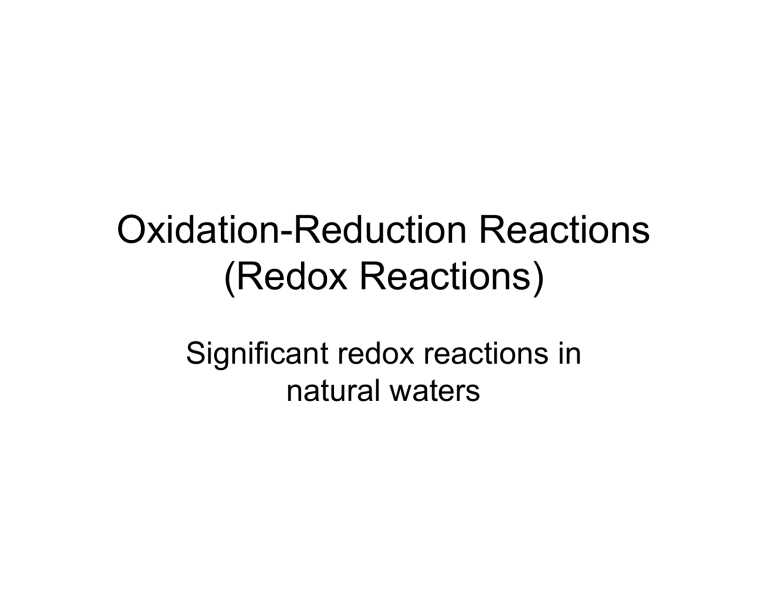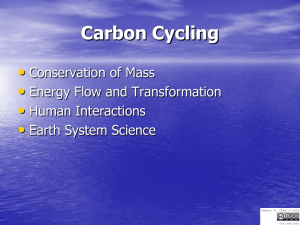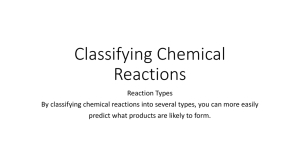Redox Reactions

Oxidation-Reduction Reactions
(Redox Reactions)
Significant redox reactions in natural waters
Topics of concern
• What is a redox reaction?
• A list of the important redox reactions in natural waters
• The role of organisms
• Where redox reactions occur
• Some important biogeochemical cycles and redox
• Summary-(or putting it all together)
The quick answers!
• Redox reactions involve the transfer of electrons (e )
• The most important reactions involve C, N,
Fe, S
• Organisms: ( prokaryotes )
– Catalyze (speed up) the reactions
– Organisms benefit by harvesting energy
• The reactions occur:
– Somewhere in the water column or in the sediment
– Or, where chemical conditions dictate
Sample oxidation-reduction reactions
.
• Oxidation of iron:
– Fe +2 Fe +3 + e -
• ( Useful mnemonic: SOIL = S ubstance O xidized
I ncreases in valence and L oses electrons )
• Reduction of oxygen:
– O
2
+ 2 H
2
O + 4 e 4 OH -
• Notes:
– Stoichiometry: everything balances (Fe, H, O, charges, etc.)
– As written, these are “ half-reactions ”. (But electrons cannot just float around!)
Oxidation and reduction occur together (to account for electrons)
• Oxidation of iron:
– Fe +2 Fe +3 + e -
• Reduction of oxygen:
– O
2
+ 2 H
2
O + 4 e 4 OH -
• Add the two reactions to account for electrons
– (4 Fe +2 = 4 Fe +3 + 4 e -+ )
– + (O
2
+ 2 H
2
O + 4 e = 4 OH -+ )
– ____________________________
– 4 Fe +2 + O
2
+ 2 H
2
O = 4 Fe +3 +4 OH -
REDOX reaction: electron has been transferred ( but we don’t see it in the balanced equation!
)
• 4 Fe +2 + O
2
+ 2 H
2
O 4 Fe +3 + 4 OH
• Note that all atoms and charges balance
-
• Note also that in addition to e , H + can also be involved in redox reactions
• This reaction will occur where there is an excess of Fe +2 and O
2
at the same time
• O
2
is the “ oxidizing agent ” and Fe +2 is the
“ reducing agent ”.
Some questions for this particular reaction.
(oxidation of ferrous iron)
• Is it important? -Sometimes
• What is the role of organisms?
– Iron oxidizing bacteria catalyze the reaction.
They harvest energy and speed the reaction.
(Sample genera are: Leptothrix, Gallionella,
Ferrobacillus ferrooxidans .)
• Where does the reaction occur?
– Where water with somewhat reducing conditions encounters the air, e.g. ground water comes to the surface, or at the sediment/water interface
Iron and the phosphorus cycle
• In oligotrophic lakes, the surface sediment is oxidized. Fe +3 traps dissolved PO sediment
4
-3 in the
• When the hypolimnion becomes anoxic, the surface layer of sediment is reduced. Fe +2 is much more soluble and diffuses into the overlying water.
• PO
4
-3 is released from the sediment.
• Lakes may become “self-fertilizing”.
Summary so far:
• Oxidation and reduction reactions are paired together, hence Redox reactions
• Redox reactions involve the transfer of electrons, e-
• Reactions are balanced for atoms and charge (both e and H + )
• Reactions occur where participating species are present in excess
What reactions are important?
An idealized oxidation-reduction system
Surplus Organic Matter
Heterotrophic organisms
CH
2
O + O
2
CO
2
+ H
(aerobic respiration)
2
O
2 CH
2
2 CO
2
O + NO
+ NH
4
+
3
+ 2 H +
+ H
2
O
CH
2
CO
2
O + 4 Fe +3
+ Fe +2 + 4 H +
2 CH
2 CO
2
2
O + SO
4
-2
+ H
2
+ 2 H
S + H
2
O
+
CH
2
0 + CH
2
CO
2
+ CH
4
O
CH
2
CO
2
O + H
2
+ 2 H
2
O
Kcal per mole of
CH2O
Δ G
-121.89
-85.88
-75.68
-32.54
-19.24
+3.90
Surplus Oxygen
Autotrophic organisms
CO
2
+ H
2
O CH
2
(photosynthesis)
O + O
2
NH
NO
+
4
3
-
+ 2 O
+ 2 H
2
+
+ H
2
O
4 Fe +2 + 4 H + +O
2
4 Fe +3 +2 H
2
O
H
2
S + 2 O
2
SO
4
-2 + 2 H +
CH
4
CO
2
+ 2 H
2
O
+ 2 H
2
O
2 H
2
+ O
2
2 H
2
O
Kcal per mole of O2
Δ G
+121.89
-36.01
-46.21
-89.35
-102.65
-125.79
An alternate view of the important reactions and where they occur
• Figure 16-2 from text
• pH = -log
10
(H + )
– Thus, low pH means high
H + potential (concentration) and very acid conditions
• pE = -log
10
(e )
– Thus, low pE means high e potential (i.e. lots of e - to reduce any available species)
• Note: pE and Eh are alternative scales for presenting electron density.
• Phase diagrams :
Another version of where reactions take place.
• Strongly reducing conditions are at the bottom of the diagram.
Phase diagram for iron
• This diagram indicates chemical conditions each iron species could be expected to dominate.
• Note that Fe +3 is the dominant species where conditions are more oxidizing, and
Fe +2 is dominant where conditions are more reducing.
What is the role of organisms?
• Organisms (mostly bacteria) catalyze all the important redox reactions.
• The bacteria involved are specialized: iron bacteria catalyze iron reactions, sulfur bacteria sulfur reactions, etc.
• Their names are sometimes a give-away:
– Oxidation of NO
2
by Nitrobacter
– Sulfate reduction by Desulfovibrio (and others)
Some useful vocabulary
• Assimilatory metabolism: organisms accumulate an element for biosynthesis
• Dissimilatory metabolism: organisms catalyze a reaction to harvest energy
(they don’t retain the element).
Three biogeochemical cycles
• Nitrogen cycle
– Reducing conditions: NH
4
+ is more stable
– Oxidizing conditions: NO
3
- is more stable
• Sulfur cycle
– Reducing conditions: S is more stable
– Oxidizing conditions: SO
4
-2 is more stable
• Carbon cycle
– Reducing conditions: methane (CH
4
– Oxidizing conditions: CO species
2
) may appear
is the most oxidized
Nitrogen is an important plant nutrient
• Plants assimilate nitrogen to use in metabolism.
• Plants assimilate either NH
4
+ or NO
3
-
– (often with a preference for ammonia)
• This nitrogen is deployed into proteins,
DNA, etc.
Nitrogen cycle: nitrate reduction
• Where there is excess organic matter but no oxygen, NO
3
can substitute for oxygen as an oxidizing agent ( dissimilatory metabolism ).
– C
6
H
12
O
6
+ 12 NO
3
12 NO
2
+ 6 CO
2
+6 H
2
O
– C
6
H
12
O
6
+ 8 NO
2
4 N
2
+ CO
2
+ 6 H
2
O
• Net effect: loss of fixed N from the ecosystem, hence the process is called
“denitrification”. Organisms are “facultative anaerobes”.
Nitrogen cycle: ammonia oxidation
• Where O
2
and NH
4
+ are both present, bacteria catalyze the oxidation of the ammonia.
– NH
4
+ + 3/2 O
2
2 H + + NO
2
+ H
2
O
– Nitrosomonas
– NO
2
+ 1/2 O
2
NO
3
-
– Nitrobacter
• The overall reaction is called “ nitrification”
– NH
4
+ + 2 O
2
NO
3
+ H
2
O + 2 H +
Nitrogen cycle
Something new under the sun
(i.e. recently discovered)
• A recent discovery is the “ anammox ” reaction.
– For ( an aerobic amm onia ox idation)
– NH
4
+ + NO
2
- N
2
+ 2 H
2
O
• Reaction has been observed in the Black Sea and the Golfo Dulce in Costa Rica (partially anaerobic marine seas). The reaction may be important because of the shortage of fixed
N in the sea. It has also been reported from
Lake Tanganyika.
Nitrogen species in stratified lakes.
The sulfur cycle: Sulfate reduction
• Where conditions are strongly reducing
(no remaining O
2
or NO anaerobic respiration.
3
), sulfate may serve as the oxidizing agent for
– 3 SO
4
-2 + C
6
H
12
O
6
6 CO
2
+6 H
2
O + 3 S -2
– Some of the bacteria that catalyze this and similar reactions are: Desulfovibrio and
Desulfotomaculum. These bacteria are obligate anaerobes.
Sulfur cycle: sulfide oxidation
• In an environment containing O
2
(sulfide) will be quickly oxidized.
, any S -
– H
2
S + 1/2 O
2
S + H
2
O
– S + 3/2 O
2
+ H
2
O H
2
SO
4
• Thiobacillus thiooxidans, Thiothrix, Beggiatoa,
• Sulfur oxidation and reduction reactions cluster along the interface between
SO
4
-2 and S -2
• No oxygen is present where S -2 is the stable species.
Various cycles may have crosslinks .
• Sulfur and nitrogen cycles:
– 5 S + 2 H
2
O + 6 NO
3
• Thiobacillus denitrificans
5 SO
4
+ 4 H + + N
2
• Iron and sulfur cycles:
– FeS
2
– Fe +2
+ 7/2 O
2
+ 1/4 O
2
+ H
+ H
2
+
O Fe +2 + 2 SO
4
-2
Fe
• Thiobacillus thiooxidans
+3 + 1/2 H
2
O
+ 2 H +
– This reaction, the oxidation of pyrite, occurs in abandoned mines and produces very strong acid.
Sulfide and phosphorus
• When the iron in the surface of the sediment is reduced to Fe +2 , PO
4
-3 is released.
• With fall turnover, Fe +2 is oxidized to Fe +3 and
PO
4
-3 is returned to the sediment
• However, if S -2 has precipitated some of the
Fe +2 , PO
4
-3 may remain in the water column
• With strongly reducing conditions, the sediment ceases to be an efficient phosphorus trap.
The carbon cycle
• The big story: CO
2
reduction to produce reduced carbon species. I.e. photosynthesis
– CO
2
+ H
2
O CH
2
O + O
2
– Most of the organic matter on earth is ultimately produced by this reaction. Almost all the primary production is via photosynthesis. (A minor exception: chemosynthesis around deep sea vents, etc.)
Carbon cycle: carbon oxidation
• The organic matter produced by photosynthesis is mostly oxidized by aerobic respiration:
– CH
2
O + O
2
CO
2
+ H
2
O
• Only where O
2
is missing will anaerobic respiration occur with NO acting as oxidizing agents
3
or SO
4
-2
• Methane is fermented where there is ample organic matter and conditions are strongly reducing
(high density of electrons).
Native C = C in organic compounds
Carbon cycle: methane production
• Where conditions are extremely reducing (very high e potential, very low pE) and no suitable oxidizing agent remains (no O2, NO
3
or SO
4
-2 ), methane fermentation may occur.
– CH
3
COOH
+ 4 H
CH
CH
4
+ CO
+ 2 H
2
– CO
2 2
Methanococcus
4 2
O
• Methanobacterium, Methanobacillus,
Carbon cycle: methane consumption
• Where methane and oxygen (only a little!) occur together, methanotrophs will oxidize methane.
– 5 CH
4
+ 8 O
2
2 CH
2
O + 3 CO
2
+ 8 H
2
O
• Methanomonas methanica, Methanomonas methanooxidans
Review
• Redox reactions involve the transfer of electrons (e )
• The most important reactions involve C, N,
Fe, S
• Organisms: ( prokaryotes )
– Catalyze (speed up) the reactions
– Organisms benefit by harvesting energy
• The reactions occur:
– Somewhere in the water column or in the sediment
– Or, where chemical conditions dictate
• Phase diagrams :
Another version of where reactions take place.
• Strongly reducing conditions are at the bottom of the diagram.
Lake type and redox conditions
• Oligotrophic Lakes: oxygen present throughout the year at all depths.
• Eutrophic Lakes: Excess organic matter leads to oxygen loss in hypolimnion during summer stratification
Meromictic lakes: extreme redox conditions
• Meromictic lakes have permanent stratification because of high salt content in the lower layer
(monimolimnion).
• Isolation from the atmosphere leads to complete anoxia.
• S -2 and methane may accumulate to high concentrations
Oligomictic lakes
• Lakes in the tropics sometimes mix only once every several year (oligomictic lakes)
• Redox conditions are likely to be intermediate between eutrophic and meromictic lakes.
• Famous example of a dangerous lake:
– Lake Nyos in West Africa
Degassing of Lake Nyos
<
http://perso.orange.fr/mhalb/nyos/index.htm
>
Summary: how it all works.
Surplus Organic Matter
Heterotrophic organisms
Kcal per mole of
CH2O
Δ G
Surplus Oxygen
Autotrophic organisms
Kcal per mole of O2
Δ G
-121.89
+121.89
CH
2
O + O
2
CO
2
+ H
(aerobic respiration)
2
O
2 CH
2
2 CO
2
O + NO
+ NH
4
+
3
+ 2 H +
+ H
2
O
CH
2
CO
2
O + 4 Fe +3
+ Fe +2 + 4 H +
2 CH
2 CO
2
2
O + SO
4
-2
+ H
2
+ 2 H
S + H
2
O
+
CH
2
0 + CH
2
CO
2
+ CH
4
O
CH
2
CO
2
O + H
2
+ 2 H
2
O
-85.88
-75.68
-32.54
-19.24
+3.90
CO
2
+ H
2
O CH
2
(photosynthesis)
O + O
2
NH
NO
+
4
3
-
+ 2 O
+ 2 H
2
+
+ H
2
O
4 Fe +2 + 4 H + +O
2
4 Fe +3 +2 H
2
O
H
2
S + 2 O
2
SO
4
-2 + 2 H +
CH
4
CO
2
+ 2 H
2
O
+ 2 H
2
O
2 H
2
+ O
2
2 H
2
O
-36.01
-46.21
-89.35
-102.65
-125.79





